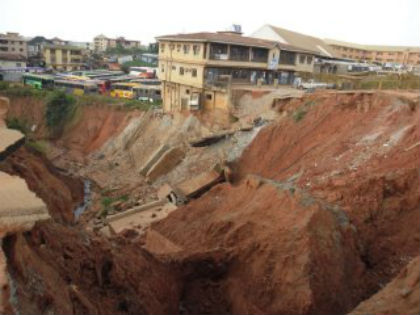The critical issues surrounding our environment in Nigeria are distinctly shared across the varying climatic belts, seeing as while the southern part of the country is inundated with phenomena relating to the continuous supply of rainfall in particular, the northern part is dominated by situations arising from the relative lack of it. When talking excess supply of rainfall, flooding easily comes to mind as the dominant puzzle to solve as cases in the commercial capital, Lagos, Ibadan and Lokoja in our recent history must have also proven to an extent. The problem here is both our eyes have been on flooding so long that another problem partly induced by rainfall also, has been allowed to develop from bad to worse over the years with little or no concern: erosion, gully erosion.

In a country where environmental hazards are often treated with the approach of curing rather than preventing, it comes as no surprise that the dangers of erosion, as is manifesting in the South-eastern part for the country, is being treated thus far, with lip-service even after many have had to abandon their homes and many high-traffic roads, federal highways included, are metamorphosing into baseless bridges. For how long will we play blind?
It is easily fathomable that, by this age, relevant authorities will see that the key to environmental sustainability lies in being proactive rather than being reactive. The approach always taken in the past where we wait to see what say erosion can do before we see what we can do about it has always come at a higher cost to our habitat and the inhabitants, and is thus one mistake that, seeing as a new government is in place centrally, we should be looking to put an end to. And that is why the situation in the south-eastern part of the country must be seen and treated as what it is: an emergency.
I had served in the East for one year and seen the level of erosive degradation first hand and many locals had described it as an anomaly and a problem. But No, an anomaly is something that is out of place. The problem of erosion in these parts is however not out of place, it is the expected result of an identified process which is understandable and preventable to some extent by appropriate land management measures. This has however been ignored for way too long.
While the point has been made that erosivity is a strong factor in the South East gully situation, the erodibility of the topography looks the bigger factor. The sedimentology of land in this part of the country is particularly dominated by a clayey topsoil which covers a deeper lying Nanka Sandstone, a type of soil which is white, of loose texture, and easily breakable. These may not be under the control of man. What is however under the control of man is the choice to manage this topography.
Oftentimes, what happens is that sheet erosion occurs firstly, washing off the top level of soil continuously, this as a result of rainfall generally, but surface runoff in particular. Are people even aware that by paving their surroundings, they are impeding infiltration capacity and thus increasing runoff? No, because ecological funds that should be disbursed towards such awareness campaigns are largely diverted. After all, they may say to themselves, I promised roads, power, but never environmental preservation during the campaigns and no one questioned me. Which is where our lack of environmental consciousness as a people is also damning.
When the topsoil is being washed off, it is a preliminary stage of a bigger problem and more or less, a warning signal. If ignored, as we have time and again, chosen to do, it leaves the weaker Nanka Sandstone with a much higher exposure to agents of denudation which brings about the development of gullies. So clearly, where a serious gully is sited, it did not develop overnight, it must have gone through several stages where it could have been nipped in the bud. That so many sites have developed across the region in even high-traffic areas only underlines how little importance, successive governments have attached to our habitat.
It was reassuring that after President Buhari assumed office, one of his first decisions was to revive the clean-up of Ogoniland which was demonstrative of how our environment must be cared for. The President went ahead to name Amina Mohammed, a former aide to the United Nations Secretary General as Minister of Environment and personally led a strong contingent to the Conference of Paris to discuss climate change. Asides that, one of the assignments carried out by the 8th Senate was the visit of the Senate Ad-hoc Committee of Works led by Senator Barnabas Gemade to some erosion sites in the South-East for first-hand appraisal. So it does appear that the environment will finally get the necessary attention under the new dispensation but one must wait and observe if action will match with words, it is a controllable situation; land management measures like tree planting must be encouraged, public awareness on corrective measures must be given emergency status, and early detection as they say, is key. It is a time for all proactive rather than wait to be pushed, but this is Nigeria and the more you look… Well, you know the rest.
By Gbolahan Yusuf, Lagos-based youthful environmentalist (gbolly1992@gmail.com, @G1gbolahan)
